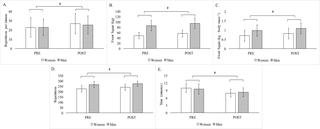PLOS ONE ( IF 3.7 ) Pub Date : 2018-06-15 , DOI: 10.1371/journal.pone.0198324 Yuri Feito , Wade Hoffstetter , Paul Serafini , Gerald Mangine

|
High Intensity Functional Training (HIFT) is a training modality, characterized by multimodal exercises performed at high-intensity. Little is known about the training adaptations that occur as a prolonged training program. The purpose of this study was to examine changes in body composition, bone metabolism, strength, and skill-specific performance over 16-weeks of HIFT. Twenty-six recreationally active adult males (n = 9; 34.2 ± 9.1 y; 91.5 ± 17.7 kg; 178.5 ± 5.4 cm) and females (n = 17 = 36.4 ± 7.9 y; 91.5 ± 17.7 kg; 162.9 ± 7.0 cm) completed pre and post training assessments of body composition (Dual-Energy X-Ray Absorptiometry) and performance measures. Performance was assessed using three HIFT workouts (WOD 1–3) to assess strength, skill, and metabolic performance. Aside from the body composition measurements, all assessments were carried out at the local training facility. Training included participation in HIFT a minimum of twice a week for 16-weeks. Repeated measures analysis of variance revealed a significant gender x time interaction in Bone Mineral Content (BMC) (p = 0.027), where improvements favored women (1.0% ± 1.1%, p = 0.004) over men (-0.1% + 0.8%, p = 0.625). Further, region-specific analysis indicated that women (2.5% ± 3.0%, p < 0.005) experienced greater improvements in the trunk compared to men (-0.3% ± 1.8%, p = 0.621), while changes in leg BMC were comparable between women (0.8% ± 1.0%, p < 0.001) and men (0.3% ± 0.6%, p < 0.001). Although no other interactions were observed, significant performance improvements were noted for all participants in WOD 1 (18.3% ± 16.8%), absolute 5RM (14.4% ± 9.7%), relative 5RM (15.4% ± 9.2%), WOD 2 (5.7% ± 6.5%), and WOD 3 (–17.3% ± 14.7%). These data indicate that 16-weeks of HIFT resulted in positive outcomes in strength, metabolic conditioning performance, and body composition.
中文翻译:

HIFT 16周引起的身体成分,骨代谢,力量和特定技能表现的变化
高强度功能训练(HIFT)是一种训练方式,其特征在于在高强度下进行的多模式锻炼。对于长时间的培训计划而产生的培训适应性知之甚少。这项研究的目的是检查HIFT在16周内的身体组成,骨代谢,强度和特定技能表现的变化。完成了二十六个娱乐活动成年男性(n = 9; 34.2±9.1 y; 91.5±17.7 kg; 178.5±5.4 cm)和女性(n = 17 = 36.4±7.9 y; 91.5±17.7 kg; 162.9±7.0 cm)完成身体组成(双能X射线骨密度仪)训练前和训练后的评估以及性能指标。使用三种HIFT锻炼(WOD 1-3)评估力量,以评估力量,技能和代谢表现。除了身体成分的测量,所有评估均在当地培训机构进行。培训包括每周至少两次参加HIFT,为期16周。重复测量方差分析发现,骨骼矿物质含量(BMC)的性别x时间交互作用显着(p = 0.027),与男性(-0.1%+ 0.8%)相比,女性(1.0%±1.1%,p = 0.004)有所改善。 p = 0.625)。此外,针对特定区域的分析表明,与男性(-0.3%±1.8%,p = 0.621)相比,女性(2.5%±3.0%,p <0.005)的躯干改善更大,而腿部BMC的变化在女性(0.8%±1.0%,p <0.001)和男性(0.3%±0.6%,p <0.001)。尽管未观察到其他交互作用,但注意到WOD 1的所有参与者(18.3%±16.8%),绝对5RM(14.4%±9.7%),相对5RM(15.4%±9)的显着性能改善。2%),WOD 2(5.7%±6.5%)和WOD 3(–17.3%±14.7%)。这些数据表明16周的HIFT在强度,代谢调节性能和身体成分方面产生了积极的结果。



























 京公网安备 11010802027423号
京公网安备 11010802027423号